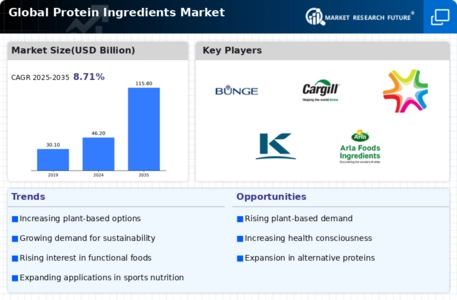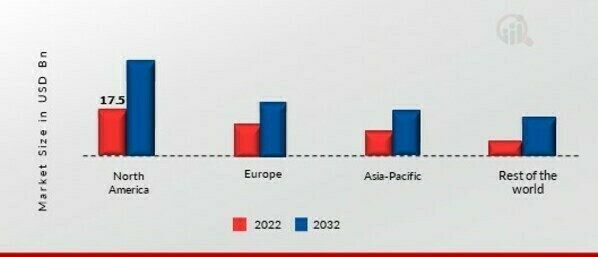-
Executive Summary
-
Introduction
-
Definition
-
Scope Of The Study
- Research Objective
- Assumption
- Limitations
-
Market Structure
-
Research Methodology
-
Introduction
-
Primary Research
-
Secondary Research
-
Secondary Research
-
Market Dynamics
-
Introduction 21
- Drivers 21
- Functional Properties
- Advancement In Technology
- Restraints
- Opportunities
- Challenges
-
Market Trends
-
Trends In Supply/Production
-
Trends In Demand/Consumption By Function
-
Emerging Markets (Supply & Demand)
-
Emerging Markets For Proteins
-
Introduction
-
Trend In Protein Concentrates And Textured Protein Substances Exports And Imports
- Trend In Protein Concentrates And Textured Protein Substances Exports
- Trend In Protein Concentrates And Textured Protein Substances Imports
-
Innovations In Products/Process In Proteins
-
Macroeconomic Indicator Analysis For Top Protein Ingredient Market
- Pestle Analysis-U.S.
- Pestle Analysis-U.K.
- Pestle Analysis-India
- Pestle Analysis-China
-
Market Factor Analysis
-
Value Chain Analysis
-
Porter’s Five Forces
- Bargaining Power Of Suppliers
- Threat Of New Entrants
- Bargaining Power Of Buyers
- Threat Of Substitutes
- Competitive Rivalry Between Existing Players
-
Supply Chain Analysis
-
Global Protein Ingredients Market- By Feedstock
-
Global Protein Ingredient Market- By Soy
-
Global Protein Ingredient Market- By Wheat
-
Global Protein Ingredient Market- By Pea
-
Global Protein Ingredient Market- By Canola
-
Global Protein Ingredient Market- By Whey
-
Global Protein Ingredient Market- By Milk
-
Global Protein Ingredient Market- By Casein
-
Global Protein Ingredient Market- By Egg
-
Global Protein Ingredient Market- By Beef
-
Global Protein Ingredient Market- By Pork
-
Global Protein Ingredient Market- By Other Ingredients
-
Global Protein Ingredients Market- By Form
-
Introduction
-
Global Protein Powder Market- By Powder
-
Global Protein Powder Market- By Bars
-
Global Protein Powder Market- By Ready To Drink
-
Global Protein Powder Market- By Capsules & Tablets
-
Global Protein Powder Market- By Other Forms
-
Global Protein Ingredients Market- By Application
-
Introduction
-
Global Protein Powder Market- By Functional Foods
-
Global Protein Powder Market- By Sports Nutrition
-
Global Protein Powder Market- By Meat Additives
-
Global Protein Powder Market- By Confectionery & Other Food Products
-
Global Protein Powder Market- By Pharmaceuticals
-
Global Protein Powder Market- By Other Applications
-
Global Protein Ingredients Market- By Region
-
Introduction
-
NORTH AMERICA PROTEIN INGREDIENTS MARKET, BY COUNTRY
-
NORTH AMERICA PROTEIN INGREDIENTS MARKET, BY FEEDSTOCK
-
NORTH AMERICA PROTEIN INGREDIENTS MARKET, BY FORM
-
NORTH AMERICA PROTEIN INGREDIENTS MARKET, BY APPLICATION
-
U.S. PROTEIN INGREDIENTS MARKET, BY FEEDSTOCK
-
U.S. PROTEIN INGREDIENTS MARKET, BY FORM
-
U.S. PROTEIN INGREDIENTS MARKET, BY APPLICATION
-
CANADA PROTEIN INGREDIENTS MARKET, BY FEEDSTOCK
-
CANADA PROTEIN INGREDIENTS MARKET, BY FORM
-
CANADA PROTEIN INGREDIENTS MARKET, BY APPLICATION
-
MEXICO PROTEIN INGREDIENTS MARKET, BY FEEDSTOCK
-
MEXICO PROTEIN INGREDIENTS MARKET, BY FORM
-
MEXICO PROTEIN INGREDIENTS MARKET, BY APPLICATION
-
Introduction
-
EUROPE PROTEIN INGREDIENTS MARKET
-
EUROPE PROTEIN INGREDIENTS MARKET BY COUNTRY
-
EUROPE PROTEIN INGREDIENTS MARKET BY FEEDSTOCK
-
EUROPE PROTEIN INGREDIENTS BY FORM
-
EUROPE PROTEIN INGREDIENTS BY APPLICATION
-
FRANCE PROTEIN INGREDIENTS BY FEEDSTOCK
-
FRANCE PROTEIN INGREDIENTS BY FORM
-
FRANCE PROTEIN INGREDIENTS BY APPLICATION
-
U.K. PROTEIN INGREDIENTS BY FEEDSTOCK
-
U.K. PROTEIN INGREDIENTS BY FORM
-
U.K. PROTEIN INGREDIENTS BY APPLICATION
-
FRANCE PROTEIN INGREDIENTS BY FEEDSTOCK
-
FRANCE PROTEIN INGREDIENTS BY FORM
-
FRANCE PROTEIN INGREDIENTS BY APPLICATION
-
ITALY PROTEIN INGREDIENTS BY FEEDSTOCK
-
ITALY PROTEIN INGREDIENTS BY FORM
-
ITALY PROTEIN INGREDIENTS BY APPLICATION
-
RUSSIA PROTEIN INGREDIENTS BY FEEDSTOCK
-
RUSSIA PROTEIN INGREDIENTS BY FORM
-
RUSSIA PROTEIN INGREDIENTS BY APPLICATION
-
REST OF EUROPE PROTEIN INGREDIENTS BY FEEDSTOCK
-
REST OF EUROPE PROTEIN INGREDIENTS BY FORM
-
REST OF EUROPE PROTEIN INGREDIENTS BY APPLICATION
-
Introduction
-
ASIA PACIFIC PROTEIN INGREDIENTS MARKET BY COUNTRY
-
ASIA PACIFIC PROTEIN INGREDIENTS MARKET BY FEEDSTOCK
-
ASIA PACIFIC PROTEIN INGREDIENTS MARKET BY FORM
-
ASIA PACIFIC PROTEIN INGREDIENTS MARKET BY APPLICATION
-
CHINA PROTEIN INGREDIENTS MARKET BY FEEDTSOCK
-
CHINA PROTEIN INGREDIENTS MARKET BY FORM
-
CHINA PROTEIN INGREDIENTS MARKET BY APPLICATION
-
THAILAND PROTEIN INGREDIENTS MARKET BY FEEDSTOCK
-
THAILAND PROTEIN INGREDIENTS MARKET BY FORM
-
THAILAND PROTEIN INGREDIENTS MARKET BY APPLICATION
-
INDIA PROTEIN INGREDIENTS MARKET BY FEDSTOCK
-
INDIA PROTEIN INGREDIENTS MARKET BY FORM
-
INDIA PROTEIN INGREDIENTS MARKET BY APPLICATION
-
AUSTRALIA PROTEIN INGREDIENTS MARKET BY FEEDSTOCK
-
AUSTRALIA PROTEIN INGREDIENTS MARKET BY FORM
-
AUSTRALIA PROTEIN INGREDIENTS MARKET BY APPLICATION
-
REST OF ASIA PACIFIC PROTEIN INGREDIENTS MARKET BY FEEDSTOCK
-
REST OF ASIA PACIFIC PROTEIN INGREDIENTS MARKET BY FORM
-
REST OF ASIA PACIFIC PROTEIN INGREDIENTS MARKET BY APPLICATION
-
REST OF THE WORLD PROTEIN INGREDIENTS MARKET BY COUNTRY
-
REST OF WORLD PROTEIN INGREDIENTS MARKET BY FEEDSTOCK
-
REST OF WORLD PROTEIN INGREDIENTS MARKET BY FORM
-
REST OF WORLD PROTEIN INGREDIENTS MARKET BY APPLICATION
-
BRAZIL PROTEIN INGREDIENTS MARKET BY FEEDSTOCK
-
BRAZIL PROTEIN INGREDIENTS MARKET BY FORM
-
BRAZIL PROTEIN INGREDIENTS MARKET BY APPLICATION
-
EGYPT PROTEIN INGREDIENTS MARKET BY FEEDSTOCK
-
EGYPT PROTEIN INGREDIENTS MARKET BY FORM
-
EGYPT PROTEIN INGREDIENTS MARKET BY APPLICATION
-
SOUTH AFRICA PROTEIN INGREDIENTS BY FEEDSTOCK
-
SOUTH AFRICA PROTEIN INGREDIENTS BY FORM
-
SOUTH AFRICA PROTEIN INGREDIENTS BY APPLICATION
-
OTHERS PROTEIN INGREDIENTS BY FEEDSTOCK
-
OTHERS PROTEIN INGREDIENTS BY FORM
-
OTHERS PROTEIN INGREDIENTS BY APPLICATION
-
Competitive Landscape
-
Introduction
-
Strategies Adopted By Key Players
-
Capacity Analysis-By Company
-
Product Analysis-By Company
-
Price Analysis- By Company
-
Company Profile
-
Archer Daniels Midland Company
- COMPANY OVERVIEW
- PRODUCT PORTFOLIO
- RECENT DEVELOPMENTS
- SWOT Analysis
-
SOLAE
- COMPANY OVERVIEW
- Financial Analysis:
- Product Portfolio:
- Recent Developments
- SWOT Analysis
-
Shandong Yuwang Industrial Co., Ltd.
- COMPANY OVERVIEW
- Financial Analysis:
- Product Portfolio:
- Recent Developments
- SWOT Analysis
-
Shandong Sinoglory Health Food Co., Ltd
- COMPANY OVERVIEW
- Product Portfolio:
- Recent Developments:
- SWOT Analysis
-
Gushen Biological Technology Group Co.,Ltd
- COMPANY OVERVIEW
- Financial Analysis:
- Product Portfolio:
- Recent Developments:
-
Solbar
- COMPANY OVERVIEW
- FINANCIAL ANANYSIS
- PRODUCT PORTFOLIO
- RECENT DEVELOPMENTS
-
NUTRIPEA
- COMPANY OVERVIEW
- Financial Analysis:
- Product Portfolio:
- Recent Developments:
-
Harbin Hi-Tech Soybean Food Co.,Ltd
- COMPANY OVERVIEW
- Financial Analysis:
- Product Portfolio:
- Recent Developments:
-
Linyi Shansong Biological PRODUCTS CO LTD
- COMPANY OVERVIEW
- Financial Analysis:
- Product Portfolio:
- Recent Developments:
-
Crown Protein
- COMPANY OVERVIEW
- Financial Analysis:
- Product Portfolio:
- Recent Developments:
-
-
List Of Tables
-
INNOVATIONS IN PRODUCTS/PROCESS IN PROTEINS 29
-
PESTLE ANALYSIS-U.S. 33
-
PESTLE ANALYSIS- U.K. 35
-
PESTLE ANALYSIS-INDIA 36
-
PESTLE ANALYSIS-CHINA 37
-
GLOBAL PROTEIN INGREDIENTS MARKET, BY FEEDSTOCK, (2023–2032), KILO TONS 47
-
GLOBAL PROTEIN INGREDIENTS MARKET, BY SOY, (2023–2032), KILO TONS 48
-
GLOBAL PROTEIN INGREDIENTS MARKET, BY WHEAT, (2023–2032), KILO TONS 48
-
GLOBAL PROTEIN INGREDIENTS MARKET, BY PEA, (2023–2032), KILO TONS 49
-
GLOBAL PROTEIN INGREDIENTS MARKET, BY CANOLA, (2023–2032), KILO TONS 50
-
GLOBAL PROTEIN INGREDIENTS MARKET, BY WHEY, (2023–2032), KILO TONS 50
-
GLOBAL PROTEIN INGREDIENTS MARKET, BY MILK, (2023–2032), KILO TONS 51
-
GLOBAL PROTEIN INGREDIENTS MARKET, BY CASEIN, (2023–2032), KILO TONS 52
-
GLOBAL PROTEIN INGREDIENTS MARKET, BY EGG, (2023–2032), KILO TONS 52
-
GLOBAL PROTEIN INGREDIENTS MARKET, BY BEEF, (2023–2032), KILO TONS 53
-
GLOBAL PROTEIN INGREDIENTS MARKET, BY PORK, (2023–2032), KILO TONS 54
-
GLOBAL PROTEIN INGREDIENTS MARKET, BY OTHER SOURCES, (2023–2032), KILO TONS 54
-
GLOBAL PROTEIN INGREDIENTS MARKET, BY FORM, (2023–2032), KILO TONS 58
-
GLOBAL PROTEIN INGREDIENTS MARKET, BY POWDER, (2023–2032), KILO TONS 58
-
GLOBAL PROTEIN INGREDIENTS MARKET, BY BARS, (2023–2032), KILO TONS 59
-
GLOBAL PROTEIN INGREDIENTS MARKET, BY READY TO DRINK, (2023–2032), KILO TONS 60
-
GLOBAL PROTEIN INGREDIENTS MARKET, BY CAPSULES & TABLETS, (2023–2032), KILO TONS 60
-
GLOBAL PROTEIN INGREDIENTS MARKET, BY OTHER FORMS, (2023–2032), KILO TONS 61
-
GLOBAL PROTEIN INGREDIENTS MARKET, BY APPLICATION, (2023–2032), KILO TONS 64
-
GLOBAL PROTEIN INGREDIENTS MARKET, BY FUNCTIONAL FOODS, (2023–2032), KILO TONS 64
-
GLOBAL PROTEIN INGREDIENTS MARKET, BY SPORTS NUTRITION, (2023–2032), KILO TONS 65
-
GLOBAL PROTEIN INGREDIENTS MARKET, BY MEAT ADDITIVES, (2023–2032), KILO TONS 66
-
GLOBAL PROTEIN INGREDIENTS MARKET, BY CONFECTIONERY & OTHER FOOD PRODUCTS, (2023–2032), KILO TONS 66
-
GLOBAL PROTEIN INGREDIENTS MARKET, BY PHARMACEUTICALS, (2023–2032), KILO TONS 67
-
GLOBAL PROTEIN INGREDIENTS MARKET, BY OTHER APPLICATIONS, (2023–2032), KILO TONS 68
-
NORTH AMERICA PROTEIN INGREDIENTS MARKET SHARE, (2023–2032), KILO TONS, BY COUNTRY 71
-
NORTH AMERICA PROTEIN INGREDIENTS MARKET SHARE, (2023–2032), KILO TONS, BY FEEDSTOCK 72
-
NORTH AMERICA PROTEIN INGREDIENTS MARKET SHARE, (2023–2032), KILO TONS, BY FORM 73
-
NORTH AMERICA PROTEIN INGREDIENTS MARKET SHARE, (2023–2032), KILO TONS, BY APPLICATION 73
-
U.S. PROTEIN INGREDIENTS MARKET SHARE, (2023–2032), KILO TONS, BY FEEDSTOCK 74
-
U.S. PROTEIN INGREDIENTS MARKET SHARE, (2023–2032), KILO TONS, BY FORM 75
-
U.S. PROTEIN INGREDIENTS MARKET SHARE, (2023–2032), KILO TONS, BY APPLICATION 75
-
CANADA PROTEIN INGREDIENTS MARKET SHARE, (2023–2032), KILO TONS, BY TYPE 76
-
CANADA PROTEIN INGREDIENTS MARKET SHARE, (2023–2032), KILO TONS, BY FORM 77
-
CANADA PROTEIN INGREDIENTS MARKET SHARE, (2023–2032), KILO TONS, BY APPLICATION 77
-
MEXICO PROTEIN INGREDIENTS MARKET SHARE, (2023–2032), KILO TONS, BY FEEDSTOCK 78
-
MEXICO PROTEIN INGREDIENTS MARKET SHARE, (2023–2032), KILO TONS, BY FORM 78
-
MEXICO PROTEIN INGREDIENTS MARKET SHARE, (2023–2032), KILO TONS, BY APPLICATION 79
-
EUROPE PROTEIN INGREDIENTS MARKET SHARE, (2023–2032), KILO TONS, BY COUNTRY 81
-
EUROPE PROTEIN INGREDIENTS MARKET SHARE, (2023–2032), KILO TONS, BY FEEDSTOCK 82
-
EUROPE PROTEIN INGREDIENTS MARKET SHARE, (2023–2032), KILO TONS, BY FORM 83
-
EUROPE PROTEIN INGREDIENTS MARKET SHARE, (2023–2032), KILO TONS, BY APPLICATION 83
-
GERMANY PROTEIN INGREDIENTS MARKET SHARE, (2023–2032), KILO TONS, BY FEEDSTOCK 84
-
Plant Protein
Animal/Dairy Proteins
Microbe Protein
Others
Protein Ingredients Application Outlook (USD Billion, 2018-2032)
Food & Beverages
Infant Formulations
Clinical Nutrition
Animal Feed
Others
North America Protein Ingredients by ProductPlant Protein
Animal/Dairy Proteins
Microbe Protein
Others
North America Protein Ingredients by ApplicationFood & Beverages
Infant Formulations
Clinical Nutrition
Animal Feed
Others
US Protein Ingredients by ProductPlant Protein
Animal/Dairy Proteins
Microbe Protein
Others
US Protein Ingredients by ApplicationFood & Beverages
Infant Formulations
Clinical Nutrition
Animal Feed
Others
CANADA Protein Ingredients by ProductPlant Protein
Animal/Dairy Proteins
Microbe Protein
Others
CANADA Protein Ingredients by ApplicationFood & Beverages
Infant Formulations
Clinical Nutrition
Animal Feed
Others
Europe Protein Ingredients by ProductPlant Protein
Animal/Dairy Proteins
Microbe Protein
Others
Europe Protein Ingredients by ApplicationFood & Beverages
Infant Formulations
Clinical Nutrition
Animal Feed
Others
Germany Outlook (USD Billion, 2018-2032)
Germany Protein Ingredients by ProductPlant Protein
Animal/Dairy Proteins
Microbe Protein
Others
Germany Protein Ingredients by ApplicationFood & Beverages
Infant Formulations
Clinical Nutrition
Animal Feed
Others
France Protein Ingredients by ProductPlant Protein
Animal/Dairy Proteins
Microbe Protein
Others
France Protein Ingredients by ApplicationFood & Beverages
Infant Formulations
Clinical Nutrition
Animal Feed
Others
UK Protein Ingredients by ProductPlant Protein
Animal/Dairy Proteins
Microbe Protein
Others
UK Protein Ingredients by ApplicationFood & Beverages
Infant Formulations
Clinical Nutrition
Animal Feed
Others
ITALY Protein Ingredients by ProductPlant Protein
Animal/Dairy Proteins
Microbe Protein
Others
ITALY Protein Ingredients by ApplicationFood & Beverages
Infant Formulations
Clinical Nutrition
Animal Feed
Others
Spain Protein Ingredients by ProductPlant Protein
Animal/Dairy Proteins
Microbe Protein
Others
Spain Protein Ingredients by ApplicationFood & Beverages
Infant Formulations
Clinical Nutrition
Animal Feed
Others
Rest Of Europe Protein Ingredients by ProductPlant Protein
Animal/Dairy Proteins
Microbe Protein
Others
REST OF EUROPE Protein Ingredients by ApplicationFood & Beverages
Infant Formulations
Clinical Nutrition
Animal Feed
Others
Asia-Pacific Protein Ingredients by ProductPlant Protein
Animal/Dairy Proteins
Microbe Protein
Others
Asia-Pacific Protein Ingredients by ApplicationFood & Beverages
Infant Formulations
Clinical Nutrition
Animal Feed
Others
China Protein Ingredients by ProductPlant Protein
Animal/Dairy Proteins
Microbe Protein
Others
China Protein Ingredients by ApplicationFood & Beverages
Infant Formulations
Clinical Nutrition
Animal Feed
Others
Japan Protein Ingredients by ProductPlant Protein
Animal/Dairy Proteins
Microbe Protein
Others
Japan Protein Ingredients by ApplicationFood & Beverages
Infant Formulations
Clinical Nutrition
Animal Feed
Others
India Protein Ingredients by ProductPlant Protein
Animal/Dairy Proteins
Microbe Protein
Others
India Protein Ingredients by ApplicationFood & Beverages
Infant Formulations
Clinical Nutrition
Animal Feed
Others
Australia Protein Ingredients by ProductPlant Protein
Animal/Dairy Proteins
Microbe Protein
Others
Australia Protein Ingredients by ApplicationFood & Beverages
Infant Formulations
Clinical Nutrition
Animal Feed
Others
Rest of Asia-Pacific Protein Ingredients by ProductPlant Protein
Animal/Dairy Proteins
Microbe Protein
Others
Rest of Asia-Pacific Protein Ingredients by ApplicationFood & Beverages
Infant Formulations
Clinical Nutrition
Animal Feed
Others
Rest of the World Protein Ingredients by ProductPlant Protein
Animal/Dairy Proteins
Microbe Protein
Others
Rest of the World Protein Ingredients by ApplicationFood & Beverages
Infant Formulations
Clinical Nutrition
Animal Feed
Others
Middle East Protein Ingredients by ProductPlant Protein
Animal/Dairy Proteins
Microbe Protein
Others
Middle East Protein Ingredients by ApplicationFood & Beverages
Infant Formulations
Clinical Nutrition
Animal Feed
Others
Africa Protein Ingredients by ProductPlant Protein
Animal/Dairy Proteins
Microbe Protein
Others
Africa Protein Ingredients by ApplicationFood & Beverages
Infant Formulations
Clinical Nutrition
Animal Feed
Others
Latin America Protein Ingredients by ProductPlant Protein
Animal/Dairy Proteins
Microbe Protein
Others
Latin America Protein Ingredients by ApplicationFood & Beverages
Infant Formulations
Clinical Nutrition
Animal Feed
Others










Leave a Comment